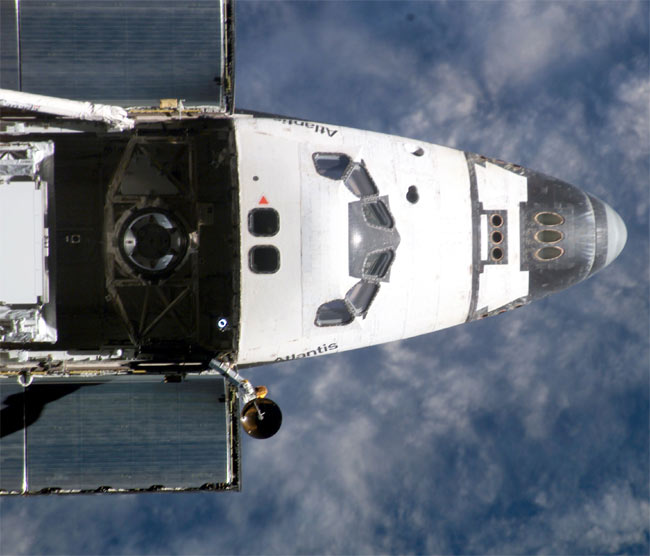NASA to Replace Antenna Bolts on Shuttle Atlantis

NASA officialshave opted to replace two bolts securing avital antenna to the cargo bay aboard the shuttle Atlantis, though theswap should not impact the vehicle's plannedAug. 27 launch date.
"We'll begetting set up this afternoon and this evening," NASA spokesperson Tracy Young,at the agency's Kennedy Space Center (KSC) launch site, told SPACE.com. "Theoperation should be done by Sunday."
Atlantisremains on track to launch toward the International SpaceStation (ISS) at 4:30 p.m. EDT (2030 GMT) on Aug. 27. The shuttle's STS-115astronaut crew is poised to deliver two girder-like trusssegments and a new set of solar arrays to the orbital laboratory duringtheir 11-dayspaceflight.
While allfour of Atlantis' Ku-band antenna bolts have performed as expected throughoutthe orbiter's 26-launch history, engineers chose to replace them rather thanrisk a failure during liftoff that could send the antenna plunging down thelength of the orbiter's 60-foot (18-meter) cargo bay.
"It wouldgo down and the damage would not be good," NASA shuttle program chief WayneHale Wednesday of the potential harm a loose antenna could cause.
During thisweekend's bolt swap, pad technicians will remove the two aft-most bolts matingAtlantis' three-foot (almost one-meter) Ku-band antenna dish to the forwardright wall of the spacecraft's cargo bay. Those two - of four total bolts - aretoo short, with only a few treads biting into their corresponding nuts.
Earlierthis week, Hale said that between six and eight engaged bolt treads are preferredfor each bolt to ensure they will hold Atlantis' 304-pound (137 kilogram)Ku-band antenna assembly fast during the eight and a half minute climb into orbit.Inspections found that only two of Atlantis' four antenna bolts were suitablysecured, though a survey of all three NASA shuttles found that some wereattached by as little as two-thirds of a tread, he added.
Breaking space news, the latest updates on rocket launches, skywatching events and more!
Similartoo-short bolts have been replaced on the Ku-band antenna assemblies aboard theDiscovery and Endeavour orbiters, both of which sit in their maintenancehangars at KSC.
Atlantis,however, sits in launch position at KSC's Pad 39B complex. To replace thebolts, technicians will work from theRotating Service Structure (RSS), which covers the orbiter's payload bay andprotects the spacecraft while at the launch pad.
Shuttleworkers will extend a retractable platform into the top of Atlantis' cargo bayjust between the orbiter's airlock and forward end of its ISS truss and solar arraypayload. From there, pad workers will set up scaffolding to reach the antennaassembly and likely carry out the actual replacement this weekend, NASA officialssaid.
The boltswap is one of two outlying issues engineers are working through for Atlantis'launch. The other is a heater thermostat glitch found in one of three auxiliarypower units (APUs) aboard the Discovery orbiter, which engineers are studyingto make sure a similar problem does not afflict Atlantis.
NASA hopesto launch Atlantis duringa window that opens on Aug. 27 and closes Sept. 7.
- NEW VIDEO: STS-115: First Tasks
- Complete Space Shuttle Mission Coverage
- NASA's STS-115: Shuttle Atlantis to Jump Start ISS Construction
- The Great Space Quiz: Space Shuttle Countdown

Tariq is the award-winning Editor-in-Chief of Space.com and joined the team in 2001. He covers human spaceflight, as well as skywatching and entertainment. He became Space.com's Editor-in-Chief in 2019. Before joining Space.com, Tariq was a staff reporter for The Los Angeles Times covering education and city beats in La Habra, Fullerton and Huntington Beach. He's a recipient of the 2022 Harry Kolcum Award for excellence in space reporting and the 2025 Space Pioneer Award from the National Space Society. He is an Eagle Scout and Space Camp alum with journalism degrees from the USC and NYU. You can find Tariq at Space.com and as the co-host to the This Week In Space podcast on the TWiT network. To see his latest project, you can follow Tariq on Twitter @tariqjmalik.
